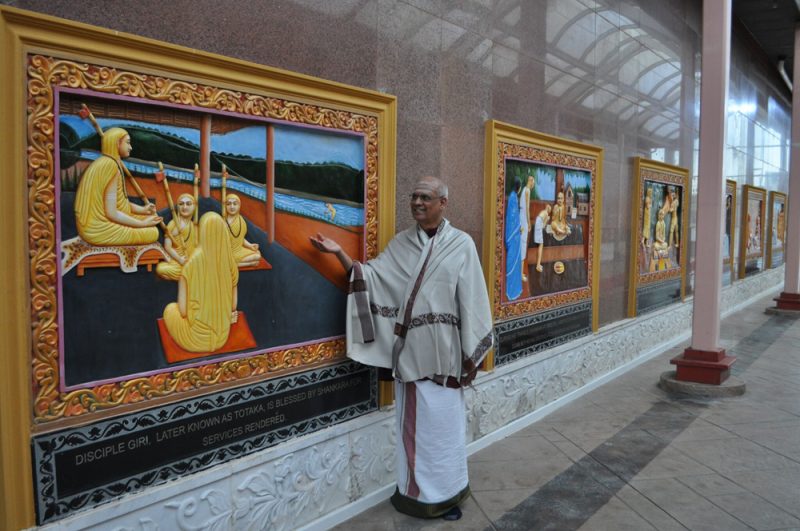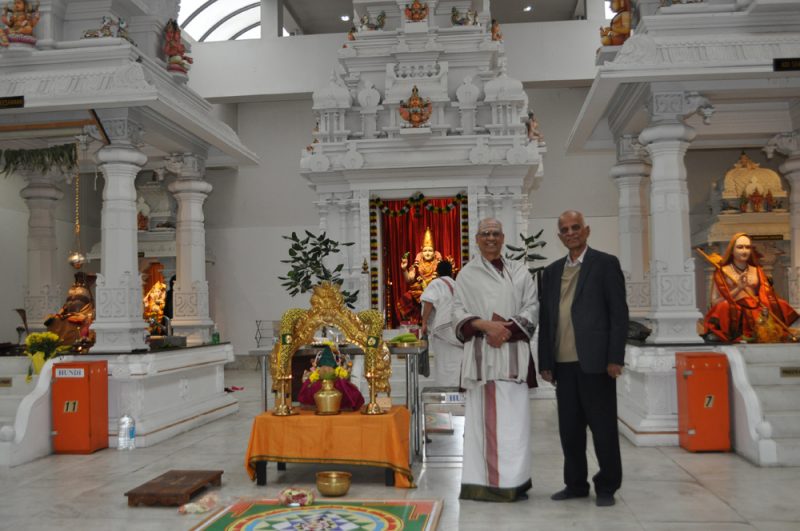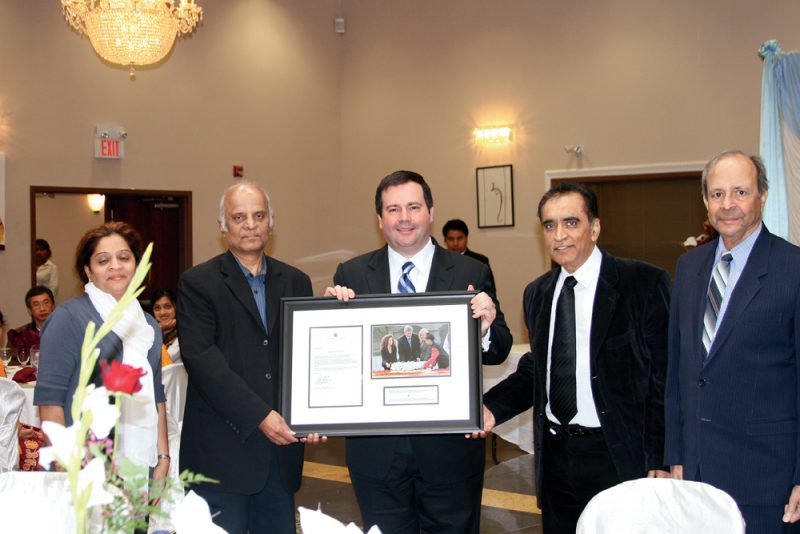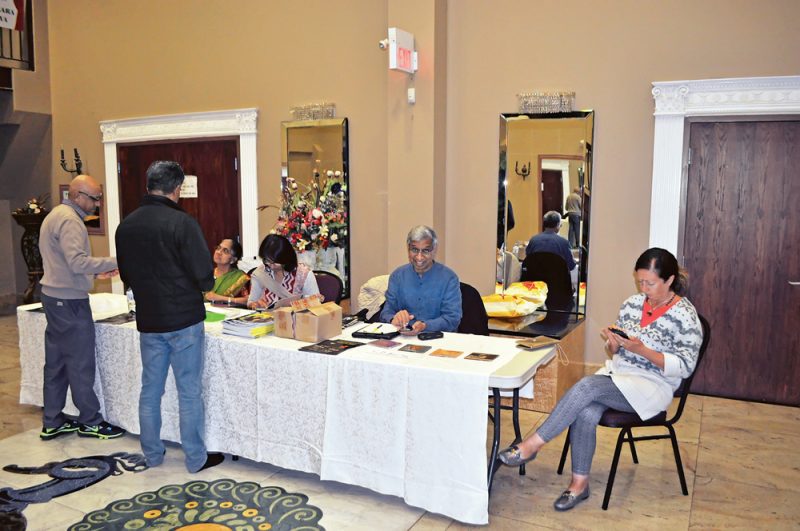Sringeri Toronto temple was thrown open to devotees on June 20, 2010
The Canadian Bazaar TORONTO: June 20, 2010, was a historic day in the history of Canada's Hindu community when the country’s first Sringeri temple opened in Toronto. On that day, thousands of devotees from Canada and the US thronged the 30,000 sq-ft temple complex to watch 20 specially trained priests flown from India perform the consecration ceremonies with `holy water’. That `holy water’ was brought from many rivers across the world, including the Ganga and the Yamuna in India and Mansarovar Lake in Tibet. The Sringeri Toronto ceremonies started on June 18 with the chanting of mantras from the Vedas by the priests to `energize’ the water for rituals. The three-day ceremonies ended with havan for the main deity Sharada-amba and the pouring of 1,008 pots of `energized’ water over the idols. Canada’s first Sringeri temple was ready for devotees as the whole temple complex was named the Sringeri Vidya Bharati Foundation (SVBF). Interestingly, Sringeri Toronto was the handiwork of all men of science and technology. IT entrepreneur Ravi Surbramanian and clean-energy scientist Lucky Lakshmanan conceived the idea of building this grand temple complex by renovating and expanding an old Shiva temple. Dr. Srinivasa Iyer Yegnasubramanian, who heads Sringeri affairs in North America, saw the project to its fruition. [caption id="attachment_68592" align="alignnone" width="800"] Dr. Srinivasa Iyer Yegnasubramanian seen in the museum SVBF Toronto.[/caption]
It took $12 million and five years to complete this marble and granite structure. Masons from Tamil Nadu were flown to build the Gopuram and the Mandapam for the temple. Marble idols and murals were crafted in Jaipur in India and brought to Canada in 11 containers.
The newly opened temple stood out for its uniqueness. It was the first Sringeri temple to have a museum on the life of the Adi Shankara – the ninth-century renaissance man of Hinduism – as well as a community centre.
Each of the 30-odd murals in the museum weighs about 350 kg and tells major events in the life of the Adi Shankara. This museum is said to be the modern-day replica of the museum at Kalady in Kerala – the birthplace of the Adi Shankara.
Interestingly, unlike south Indian temples which have black idols, this temple has white (marble) idols for the sake of the people of north India.
``The Sringeri temple has been designed for all Indians as it has 11 deities which are worshipped by all Hindus,’’ says SVBF trustee Chand Kapoor.
Within seven years of its opening, the Sringeri Toronto temple complex has become a major centre of spiritualism and cultural activities in Canada.
As Dr. Srinivasa Iyer Yegnasubramanian, chairman of the SVBF in Canada and the US, explains, ``Sringeri institutions in North America have been created not only to provide spiritual fulfilment but also raise awareness about our religious heritage among the Indian generations born here.’’
[caption id="attachment_68593" align="alignnone" width="800"]
Dr. Srinivasa Iyer Yegnasubramanian seen in the museum SVBF Toronto.[/caption]
It took $12 million and five years to complete this marble and granite structure. Masons from Tamil Nadu were flown to build the Gopuram and the Mandapam for the temple. Marble idols and murals were crafted in Jaipur in India and brought to Canada in 11 containers.
The newly opened temple stood out for its uniqueness. It was the first Sringeri temple to have a museum on the life of the Adi Shankara – the ninth-century renaissance man of Hinduism – as well as a community centre.
Each of the 30-odd murals in the museum weighs about 350 kg and tells major events in the life of the Adi Shankara. This museum is said to be the modern-day replica of the museum at Kalady in Kerala – the birthplace of the Adi Shankara.
Interestingly, unlike south Indian temples which have black idols, this temple has white (marble) idols for the sake of the people of north India.
``The Sringeri temple has been designed for all Indians as it has 11 deities which are worshipped by all Hindus,’’ says SVBF trustee Chand Kapoor.
Within seven years of its opening, the Sringeri Toronto temple complex has become a major centre of spiritualism and cultural activities in Canada.
As Dr. Srinivasa Iyer Yegnasubramanian, chairman of the SVBF in Canada and the US, explains, ``Sringeri institutions in North America have been created not only to provide spiritual fulfilment but also raise awareness about our religious heritage among the Indian generations born here.’’
[caption id="attachment_68593" align="alignnone" width="800"] Dr. Srinivasa Iyer Yegnasubramanian and Dr Lucky Lakshmanan seen in Sringeri Toronto temple.[/caption]
According to him, "Wrong practices were rampant in Hinduism when the Adi Shankara was born. He helped people break shackles of ignorance by teaching them Advaita (non-dual) Vedantic knowledge. Wherever he went, he would have debates with scholars and enlighten them with Advaita Vedanta. Sringeri temples in the West teach his philosophy and propagate it to the generations born here.’’
As the guide for the two Sringeri temples in North America, he oversees strict observance of Sringeri traditions and rituals at these temples.
"I guide the SVBF in North America. At the local level (Toronto), the president takes care. For my part, I seek guidance from Sringeri Peetham in India through the CEO and whenever I am in Sringeri, I seek guidance from the Guruji (the Shankaracharya).’’
Explaining the strict Sringeri traditions that the temples follow, he says it is mandatory to use `ahimsa ghee‘ for havan, puja and other rituals at the temples.
What is `ahimsa ghee’?
It is not the pasteurized butter that people buy in the market. `Ahimsa ghee‘ is prepared in an Indian traditional way from milk procured from home-raised cows.
[caption id="attachment_68597" align="alignnone" width="800"]
Dr. Srinivasa Iyer Yegnasubramanian and Dr Lucky Lakshmanan seen in Sringeri Toronto temple.[/caption]
According to him, "Wrong practices were rampant in Hinduism when the Adi Shankara was born. He helped people break shackles of ignorance by teaching them Advaita (non-dual) Vedantic knowledge. Wherever he went, he would have debates with scholars and enlighten them with Advaita Vedanta. Sringeri temples in the West teach his philosophy and propagate it to the generations born here.’’
As the guide for the two Sringeri temples in North America, he oversees strict observance of Sringeri traditions and rituals at these temples.
"I guide the SVBF in North America. At the local level (Toronto), the president takes care. For my part, I seek guidance from Sringeri Peetham in India through the CEO and whenever I am in Sringeri, I seek guidance from the Guruji (the Shankaracharya).’’
Explaining the strict Sringeri traditions that the temples follow, he says it is mandatory to use `ahimsa ghee‘ for havan, puja and other rituals at the temples.
What is `ahimsa ghee’?
It is not the pasteurized butter that people buy in the market. `Ahimsa ghee‘ is prepared in an Indian traditional way from milk procured from home-raised cows.
[caption id="attachment_68597" align="alignnone" width="800"] The then immigration minister Jason Kenney at the inauguration of SVBF Toronto in June 2010.[/caption]
"We don’t buy any milk products from the market. We import some `ahimsa ghee’ from India. At the Stroudsburg Sringeri temple in Pennsylvania, we have a barn of 5-6 cows and we use their milk for preparing `ahimsa ghee’ for all religious needs. We also get `ahimsa ghee’ supplies from the Hare Krishna temple at New Vrindaban in West Virginia,’’ says Dr Yegnasubramanian.
The Sringeri temple in Toronto is also looking for a place to set up its own cow barn.
``Since the Sringeri temple in Toronto is in an industrial area, we cannot set up a cow barn there. So we are looking for land somewhere so that we could raise cows. The three new Sringeri temples coming up in Detroit, Houston and San Diego will have cow barns for this purpose,’’ he says.
How similar are the Sringeri temples in Canada and the US to the original temple in India?
``The one in India is the first-ever matha established by the Adi Shankara. The Sringeri temples in Canada and the US are not its replica, but they incorporate several of the deities worshipped in Sringeri. Apart from the presiding deity Sharada-amba, the temples in the US and Canada have added other deities to suit the local needs of worshippers. But we strictly follow the traditions laid down by the Shankaracharya,’’ says Dr. Yegnasubramanian.
[caption id="attachment_68599" align="alignnone" width="800"]
The then immigration minister Jason Kenney at the inauguration of SVBF Toronto in June 2010.[/caption]
"We don’t buy any milk products from the market. We import some `ahimsa ghee’ from India. At the Stroudsburg Sringeri temple in Pennsylvania, we have a barn of 5-6 cows and we use their milk for preparing `ahimsa ghee’ for all religious needs. We also get `ahimsa ghee’ supplies from the Hare Krishna temple at New Vrindaban in West Virginia,’’ says Dr Yegnasubramanian.
The Sringeri temple in Toronto is also looking for a place to set up its own cow barn.
``Since the Sringeri temple in Toronto is in an industrial area, we cannot set up a cow barn there. So we are looking for land somewhere so that we could raise cows. The three new Sringeri temples coming up in Detroit, Houston and San Diego will have cow barns for this purpose,’’ he says.
How similar are the Sringeri temples in Canada and the US to the original temple in India?
``The one in India is the first-ever matha established by the Adi Shankara. The Sringeri temples in Canada and the US are not its replica, but they incorporate several of the deities worshipped in Sringeri. Apart from the presiding deity Sharada-amba, the temples in the US and Canada have added other deities to suit the local needs of worshippers. But we strictly follow the traditions laid down by the Shankaracharya,’’ says Dr. Yegnasubramanian.
[caption id="attachment_68599" align="alignnone" width="800"] Volunteers at SVBF Toronto.[/caption]
A Ph.D in material sciences, Dr Yegnasubramanian is steeped in the spiritualism of Sringeri.
``I teach the scriptures and give lectures on the Gita, Vedanta, the philosophy of the Adi Shankara to people of all ages. I am very happy that even our third or fourth-generation Indians here have now become interested in their roots. Teachings at the Sringeri temples have exposed them to their roots,’‘ he says.
Highlighting the importance of the museum at Sringeri Toronto, he says, "t is a unique thing. The murals in the museum depict the whole life of the Adi Shankara – from childhood to becoming a great seer.’’
Dr Yegnasubramanian thanks the followers of Sringeri Peetham for contributing to the running of the temples in the US and Canada. ``The first source of income for our temples are the offerings of the devotees. But then there are countless followers of the Shankaracharya spread all over North America who are supporting these institutions with donations,’’ he says.
Volunteers at SVBF Toronto.[/caption]
A Ph.D in material sciences, Dr Yegnasubramanian is steeped in the spiritualism of Sringeri.
``I teach the scriptures and give lectures on the Gita, Vedanta, the philosophy of the Adi Shankara to people of all ages. I am very happy that even our third or fourth-generation Indians here have now become interested in their roots. Teachings at the Sringeri temples have exposed them to their roots,’‘ he says.
Highlighting the importance of the museum at Sringeri Toronto, he says, "t is a unique thing. The murals in the museum depict the whole life of the Adi Shankara – from childhood to becoming a great seer.’’
Dr Yegnasubramanian thanks the followers of Sringeri Peetham for contributing to the running of the temples in the US and Canada. ``The first source of income for our temples are the offerings of the devotees. But then there are countless followers of the Shankaracharya spread all over North America who are supporting these institutions with donations,’’ he says.